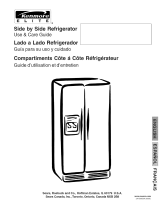
These Guidelines Must Be FollowedTo EnsureThat
Safety MechaniSmS In This Refrigerator Will
Operate Properly.
ELECTRICAL INFORMATION
• The refrigerator must be plugged into its own
dedicated 115 Volt, 60 Hz., AC only electric outlet.
The power cord of the appliance is equipped with a
three-prong grounding plug for your protection against
electrical shock hazards. It must be plugged directly
into a properly grounded three-prong receptacle. The
receptacle must be installed in accordance with local
codes and ordinances. Consult a qualified electrician.
Do not use an extension cord or adapter plug.
• Immediately repair or replace any power cord that
becomes frayed or damaged.
• Never unplug the refrigerator by pulling on the power
cord. Always grip the plug firmly, and pull straight out
from the receptacle to prevent damaging the power cord.
• Unplug the refrigerator before cleaning and before
replacing a light bulb to avoid electrical shock.
• Performance may be affected if the voltage varies by
10% or more. Operating the refrigerator with insufficient
power can damage the compressor. Such damage is
not covered under your warranty.
• Do not plug the unit intoan outlet controlled by a wall
switch or pull cord to prevent the refrigerator from being
turned off accidentally.
• Avoid connecting refrigerator toa Ground Fault Interruptor
(GFI) circuit.
IMPORTANT: Turning the refrigerat0i temperature
control to "o" turns off the compressor and prevents
your refrigerator from cooling, but does not disconnect
the power to the light bulbs and other electrica!
components.To turn off power to your refrigerator you
must unplug the power cord from the wa Ioutlet.
f" Donot,.rider
I or bypass the |
grounding prong. _)
KENIVIORE ELITE APPLIANCE WARRANTY
One Year Limited Warranty
When installed, operated and maintained according to all
instructions supplied with the product, if this appliance fails due
to a defect in material or workmanship within one year from the
date of purchase, call 1-800-4-MY-HOME ®to arrange for free
repair.
LIMITED FIVE YEAR WARRANTY ON SEALED
REFRiGERATiON SYSTEM
For five years from the date of purchase, when this appliance
is installed,operated, and maintained according to the
instructions supplied with it, Sears will repair the sealed system
(consisting of refrigerant, connecting tubing, and compressor),
free of charge, if defective in material or workmanship.
If this appliance is used for other than private family purposes,
this warranty applies for only 90 days from the date of purchase.
This warranty covers only defects in material and workman-
ship. Sears will NOT pay for:
1. Expendable items that can wear out from normal use,
including but not limited to filters, belts, light bulbs and bags.
2. A service technician to instruct the user in correct product
installation, operation or maintenance.
3. A service technician to clean or maintain this product.
4. Damage to or failure of this product if it is not installed,
operated or maintained according to all instructions supplied
with the product.
5. Damage to or failure of this product resulting from accident,
abuse, misuse or use for other than its intended purpose.
6. Damage to or failure of this product caused by the use of
detergents, cleaners, chemicals or utensils other than those
recommended in all instructions supplied with the product.
7. Damage to or failure of parts or systems resulting from
unauthorized modifications made to this product.
Disclaimer of implied warranties; limitation of remedies
Customer's sole and exclusive remedy under this limited
warranty shall be product repair as provided
herein. Implied warranties, including warranties of
merchantability or fitness for a particular purpose, are limited to
one year or the shortest period allowed by law. Sears shall not
be liable for incidental or consequential damages. Some states
and provinces do not allow the exclusion or limitation of
incidental or consequential damages, or limitations on the
duration of implied warranties of merchantability or fitness, so
these exclusions or limitations may not apply to you.
This warranty applies only while this appliance is used in the
United States and Canada.
This warranty gives you specific legal rights, and you may also
have other rights which vary from state to state.
Sears, Roebuck and Co., Dept. 817WA, Hoffman Estates, IL
60179
Sears Canada Inc.,Toronto, Ontario, Canada M5B 2B8























